How to learn to play the button accordion?
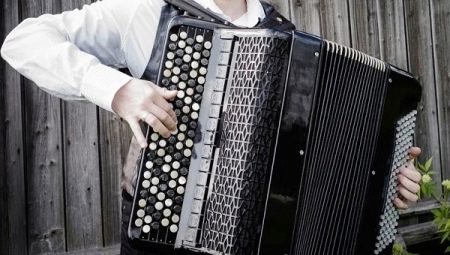
In our country, playing the button accordion attracts many people who want to get involved in music. But one should not be surprised at this situation, since the sounds of this truly folk musical instrument with a wonderful timbre are very close to the emotional experiences - joyful or sad - of a Russian person. And those who will apply maximum attention, perseverance and perseverance to learning will certainly be able to master the button accordion on their own.
What needs to be considered?
It is easier for a beginner to start learning to play a ready-made (ordinary three-row) button accordion, which has three rows of buttons in the right keyboard. It will be much faster to master the game on this instrument than on a five-row professional - ready-to-use - instrument.
In addition, in the first in the accompanying (left) keyboard, certain chords sound when you press just one button with your finger. And for a ready-to-use model, any triad can be obtained in the same way as on the right keyboard - selectively (that is, by simultaneously pressing several buttons with different fingers). Each button here makes only one sound. True, the accompanying keyboard of the ready-to-use button accordion can be switched to the normal (ready) position using the register. But this is still a professional instrument with a large number of buttons in both the left and right keyboards, which will cause unnecessary anxiety for a beginner self-taught accordion player.
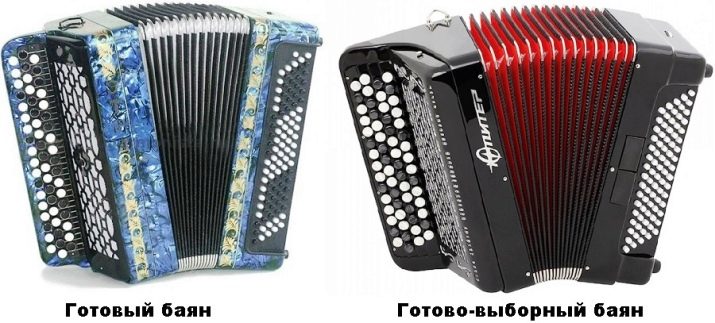
When choosing an instrument, you must also take into account the physical data of the student. Perhaps, to begin with, the purchase of a half-bayan, which has less weight, dimensions and the number of buttons on both keyboards, would be a completely correct decision.
Such an instrument can be chosen not only for children, but also for women who, at first, will find it difficult to control a rather bulky instrument with a full range of sounds.
Impatient people should consider the following points of learning to play the button accordion (so as not to be disappointed later):
- the instrument is quite complex in terms of technique, although the first lessons may seem unusually interesting, exciting;
- it is unlikely that you will be able to quickly learn to play well, so you need to be patient and persistent;
- to facilitate and accelerate learning, you will need to master musical notation and some knowledge of music theory.
In addition to all that has been said, before class it will be useful to remember a good saying about repetition, which is the "mother of learning." In practical lessons, it is necessary to repeat exercises as often as possible and with high quality, aimed at practicing various techniques for playing the button accordion, developing independence and fluency of fingers, and sharpening the ear for music.
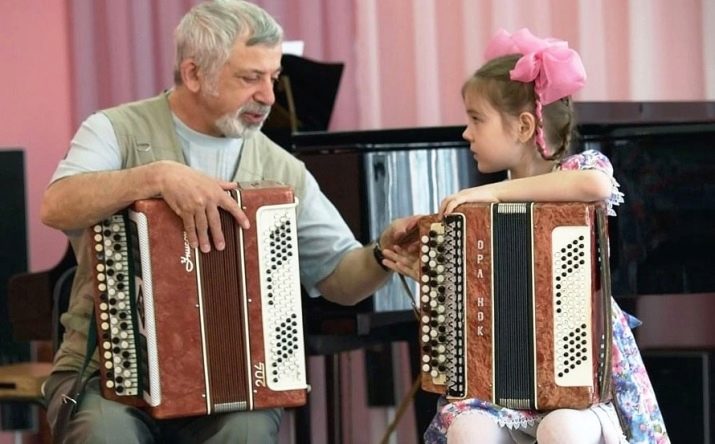
How to hold the instrument?
The accordion can be played both sitting and standing. But it is better to learn in a seated position - holding the instrument on the weight is quite tiring even for an experienced accordion player. When playing while standing, the back and shoulders are especially tired.
It is absolutely unacceptable for children to practice in a standing position.
The rules of landing with the tool are reduced to the fulfillment of the following basic requirements.
- You need to sit on a chair or stool of such a height that, with the correct setting of the legs, the knees have a slight slope towards the outside of the seated person.
- Correct positioning of the legs: the left leg is slightly set aside and forward in relation to the location of the foot of the right leg, standing on the line of the right shoulder and forming an almost right angle with both the surface of the floor and its own thigh. In this case, both legs rest on the floor with the entire area of the feet.
- Sitting correctly in a chair means the following: seating on the seat should be shallow - at most half of it, ideally - 1/3. A musician should have 3 points of support when playing: 2 feet on the floor and a chair seat. If you sit on a full seat, the support on your legs weakens, which leads to an unstable fit of the accordion player.
- The button accordion is placed with fur on the thigh of the left leg, and the neck of the right keyboard rests on the inner side of the right thigh. This position ensures the stability of the instrument when the bellows is compressed while playing. When stretching the fur, the main means of fixing the instrument are the shoulder straps (they play the same role, of course, when the fur is squeezed, in addition to resting the neck of the right keyboard against the thigh of the right leg).
- You need to sit straight, not deviating either to the left or to the right on any one leg. But a slight forward tilt of the body makes it easier to play the instrument, but the angle of inclination depends on the size of the button accordion and the musician's equipment. The main thing is that the weight of the instrument mainly falls on the legs, and not on the back.
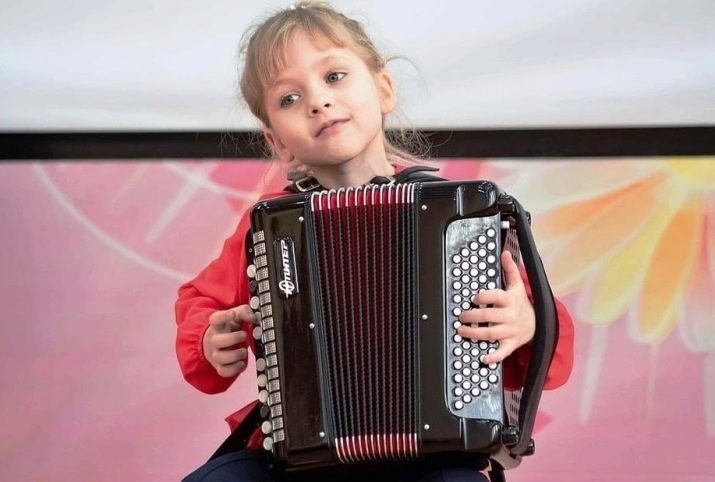
As a result of the described fit, the accordion player's right hand gains freedom of action on the keyboard when squeezing the fur. She does not have to hold the instrument to prevent it from shifting to the right side (this role is played, as explained above, by the thigh of the right leg). The shift of the accordion player to the left when stretching the fur is prevented by the left leg slightly set aside to the same side. In addition, the latter also provides additional stability for the musician with the instrument due to a slight protrusion forward in relation to the line of the right foot.
Learning stages
For beginners to play the button accordion from scratch, it is important to organize their training so that there are no long breaks in the learning process. A day or two, if necessary, is a perfectly acceptable pause for adult students busy with work and caring for the family.
Children, however, are advised not to arrange vacations for themselves, even for one day.
True, parental control is needed here, especially at the initial stage of training, when fingers are trained to develop their independence, stretching, and scales and musical notation are studied. For many adults and almost all children, classes at the initial stage seem boring and uninteresting. Later, when the playing of famous melodies with two hands begins, young accordion players no longer need strict control.

The method of initial mastering the technique of playing the instrument includes two stages:
- pre-game;
- game.
Both of these main stages are subdivided, in turn, into 2 more periods.
The pre-game stage is divided into the following points:
- the period of development of musical abilities and hearing;
- the period of practicing the landing and the formation of the student's musical tone.
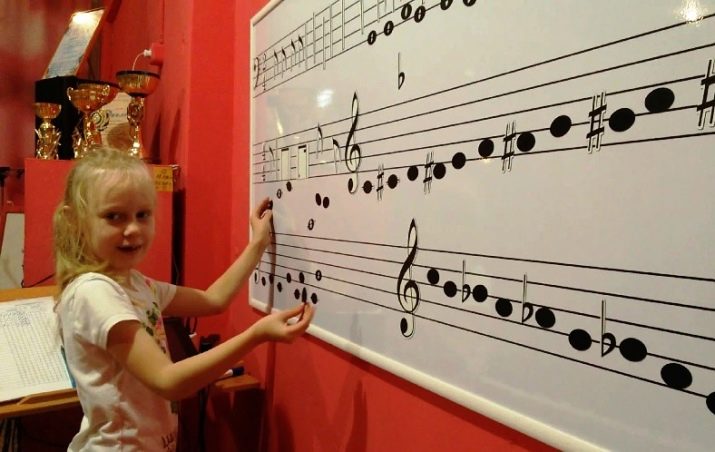
The period of development and identification of the performing abilities of a future musician is possible only in the case of classes with a teacher. A beginner himself (including an adult) is unlikely to think of independently organizing music listening lessons for himself, much less analyzing it. This is what is primarily meant by the tasks of this period of the pre-game stage. This also includes singing and the formation of a sense of rhythm, which can also be realized only with a professional.
The period of practicing the landing and the development of playing tone is a very important milestone in the pre-game stage of training beginners. Here you need to learn how to properly sit with the instrument, hold it, perform a set of exercises for practicing independent finger movements and their sensitivity.
And you also need to train the muscles of the hands and perform exercises to develop coordination and touch. If you do not prepare a student for playing the button accordion, then subsequently there may be major problems in the performing technique, which are very difficult to solve.
The game stage includes the following periods:
- studying the left and right keyboards of the instrument, mastering the principles of mechanical science;
- musical notation, playing by ear and notes.

The study of keyboards should begin with the buttons designed to be played with the fingers of the right hand, since with the left hand, beginners begin to act much later (when they are fully familiar with the melodic keyboard, they will be able to confidently play not only scales, but also pieces, simple busting).
The basic principles of mechanics for beginners can be expressed in the following rules:
- it is necessary to calculate the direction of the fur in one direction so that it is enough to play at least one phrase of a piece of music or, for example, to sound a two-octave scale in the upward direction (then its downward direction will fall on the movement of the fur in the opposite direction);
- you cannot interrupt a long note, which was inadvertently started when the fur moves in one direction, but due to a lack of reserve, continuing its sound by changing the direction of movement to the opposite (such techniques are not yet available to beginners);
- when playing, you never need to stretch or squeeze the fur until it stops - you should definitely keep a small margin of movement.
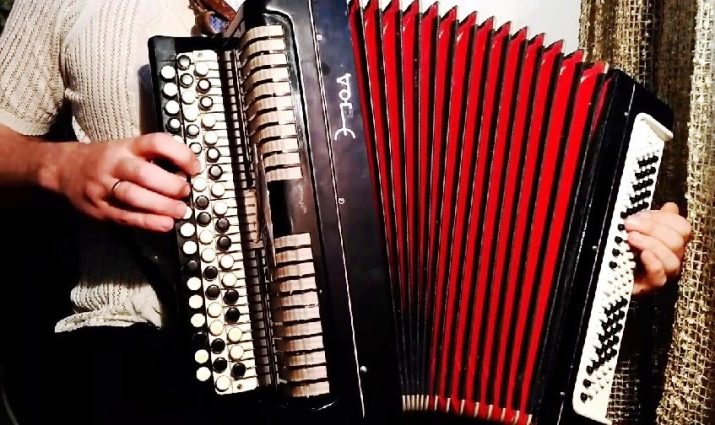
The student should understand that the dynamics (volume) of the sound on the accordion is regulated precisely by the intensity of movement of the fur: to increase the volume, the fur needs to be squeezed or moved apart faster. In addition, other musical techniques and effects (staccato, vibrato, and so on) are performed with fur.
Gamma
Playing on the right accordion keyboard (and later on the left) should begin with learning and playing scales. First of all, of course, those scales are played, the sounds of which do not have sharps (flats) - that is, only the white keyboard buttons are used. These scales are C major and A minor. Playing scales develops the musician's hearing, independence of the fingers, teaches them to the correct order of the fingers when playing long losses (forms the correct fingering), helps to quickly memorize notes on the keyboard.
Below are both mentioned scales.
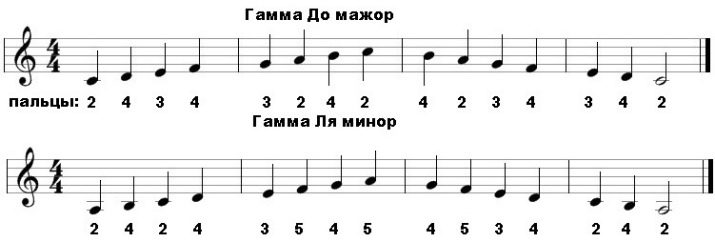
Scales should be played in a wide variety of time signatures: 4/4, 3/4, 6/8, and 2/4.
In this case, it is imperative to accentuate the strong beats (the first notes of all measures).
Playing by notes
With musical notation, you can start "making friends" even from the pre-game stage:
- to understand that a note sign in itself is a designation of the duration of some indefinite sound, and placed on the staff (staff) also indicates a specific sound in pitch (for example, "to" of the second octave or "mi" of the first octaves);
- to begin with, memorize the longest-sounding notes: whole for 4 counts, half for 2 counts and quarter for 1 count;
- learn how to write notes of the passed durations on a regular sheet of paper, figure out what parts the notes are made of (the note itself is a colorless or black oval, calm);
- get acquainted with the staff and the treble clef, learn how to draw the treble clef and musical notation on the staff (you will need a music book);
- a little later, when it’s time to play the left keyboard, consider in the same way what the stave in the bass clef “F” is, what notes and in what order it contains.
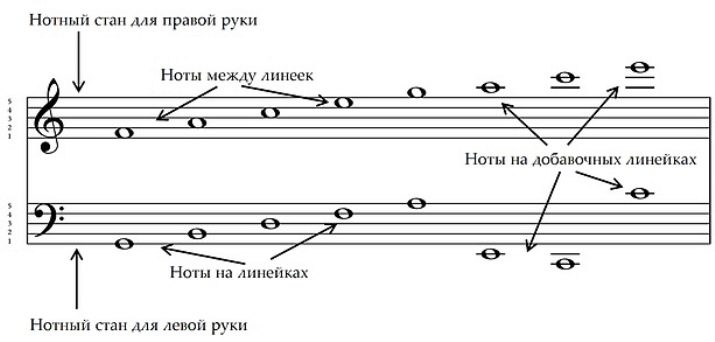
The next step is to learn which buttons on the right keyboard must be pressed sequentially to play the C major scale from "C" of the first octave to the note "C" of the second octave. Record these sounds (notes) on the staff in quarter durations and sign the fingering (fingers) of the right hand for each note, as described in the example above.
Pick up an instrument and play a scale, observing the fingering (fingering) and the duration of the sounds (by 1 count). You need to play the scale in an upward movement, and then - in a downward one, without stopping or repeating the "C" note of the second octave.
Having learned the one-octave scale of C major by heart, in the same way, you need to write down the one-octave scale of A minor (from "A" of the first octave to "A" of the second octave) with fingering in a music book. After that, play it until you are completely memorized.
But there is no need to dwell on this. You can always buy small collections of notes of your favorite songs or popular melodies of the world. Most often they are sold only as monophonic melodies. For beginners, it will be just useful and interesting to disassemble them on the melodic keyboard. You can try to pick up familiar musical compositions by ear. Such classes are very useful for the future musician.

Advice
To improve their performing level later, as well as to go through the first stages of training, I would like to recommend that beginner accordion players who have decided to learn to play on their own, nevertheless, periodically seek help from professional button accordion or accordion teachers.
Of course, you can study on your own, for example, according to a self-instruction manual or a school for playing the button accordion, but such a process can take a long time, if not forever. There are nuances that only an experienced accordion player knows. The button accordion is a rather difficult instrument to master on your own. This must be remembered and be prepared for mistakes that certainly accompany self-taught: improper fit, irrational fingering, poor hand placement, fake notes and chords, nervous and uneven playing, inability to work correctly with fur. It is best to avoid this with just a few lessons from a specialist, especially at first.
But if it is not possible to find a teacher, then you should definitely learn musical literacy from a self-instruction manual, and then consistently and very carefully go through the lessons offered in the textbook.









